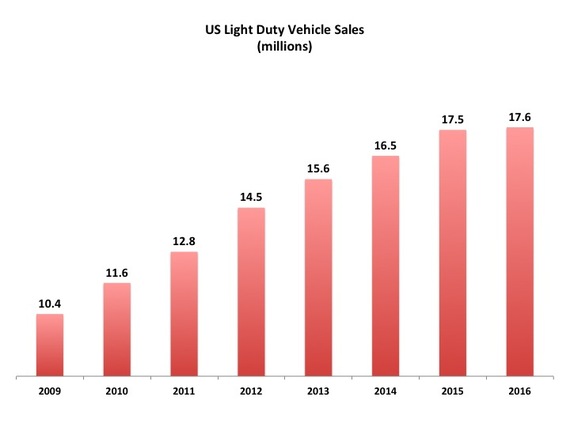During his Senate confirmation hearings last week, Scott Pruitt, President Trump's nominee for EPA administrator, made a lot of questionable claims about his ties to the oil industry, his environmental credentials and climate science denial. Less noticed, but just as flawed, were his statements regarding a specific regulations: the current greenhouse gas emissions and fuel efficiency standards for automobiles.
These standards, which run through 2025, are the Obama administration's greatest success in combatting climate change. Between 2012 and 2025 these regulations will save twelve billion barrels of oil and prevent six billion metric tons of greenhouse gases from entering the atmosphere, all while providing American drivers trillions of dollars in fuel savings. These rules are already proven to work.. Over the first four years, the targets have been exceeded by an auto industry that is also experiencing record sales and healthy profits.
Neither were these rules forced upon automakers, who largely agreed to negotiated standards. As part of that agreement with automakers, the EPA conducted a mid-term review last year. Their conclusion: the auto industry could meet the standards at a lower cost than anticipated and that the auto industry was, in fact, ahead of schedule in meeting those standards. So why would Pruitt re-open a legally binding decision that is, by almost any measurement, a successful win-win regulation for the environment, consumers and industry?
As is commonly the case with Pruitt, he is listening to voices in the auto industry - the same industry that willingly agreed to the 2025 national program five years ago - who are now trying to turn back the clock on fuel efficiency and greenhouse gas reduction. Weakening the rules may result in at least a short-term rise in profits. By any other standard, attempting to change the rules regarding fuel efficiency and environmental protection will be a disaster. Pruitt's suggestion will create instability in the market, hurt jobs in the US, discourage innovation and reduce American manufacturing competitiveness abroad.
Destabilizing the Market
First of all, such a change in existing rules will likely be very messy. Even as EPA administrator, Pruitt cannot unilaterally change current regulation. In so doing, he would be repealing the action made by a former EPA administrator, which is backed by the enormous amounts of research, science, policy and legal work conducted by EPA, California Air Resources Board staff, International Council of Clean Transportation (ICCT) and other experts.
Reversing the decision would not be supported by the record, would be considered unlawful by many stakeholders, and will inevitably result in lawsuits by environmental groups and perhaps individual states. The plaintiffs would even be able to use the existing EPA work confirming the standards against Pruitt's EPA in the lawsuits. Whatever the end result of any legal action, the legal impediments and bureaucratic processes would mean it would take 2-3 years to finalize any new rules. And, ultimately, Pruitt's action would only affect the tail end of the program, from 2022-2025. The standards through 2021 are already locked in. None of this is good news for auto companies, which need to plan their research and production schedules years in advance. Today they have certainty about government standards; changing the rules will create instability.
Additionally, any change to federal rules regarding greenhouse gas (GHG) standards also has to take into account the position of a single state: California. Not only does the Golden State have the 6th largest economy in the world and the nation's largest auto market, it is uniquely allowed to set its own GHG standards. Under the current national regulations, California agreed to harmonize their more progressive standards with the EPA's national program. If Pruitt pulls back national standards, California regulators and politicians have already made clear that they will not be following his lead. The president of California's senate, Kevin de Leon reaffirmed the state's progressive view. "California will continue to lead the world in addressing climate change and advancing clean energy regardless of who is in the White House or at the EPA," said de Leon. "Mr. Pruitt should get used to that and not try to impose his Oklahoma views on the Golden State."
California's firm commitment to hold steady on its state vehicle standards will collide with any move to weaken the EPA's national standards. The result will be a situation in which automakers who choose to manufacture cars that don't meet California standards will either have to sell a different model in that state - or not sell those cars in the country's biggest market.
What's more, any other state can choose to adopt the more stringent standards set by California. In the past, states representing roughly half of the US market adopted California standards. So, on top of the instability inherent in changing existing EPA rules, automakers will face the prospect of an extremely fractured market.
Innovation and Jobs
Like all the best regulation, the existing rules covering fuel efficiency and greenhouse gas emissions do not prescribe solutions. Instead they set carefully researched and feasible standards and then let the market compete to create the new technologies needed to meet them. When automakers and parts suppliers see that there will be a sustained demand for more efficient, cleaner cars, they are willing to invest some of their massive developmental budget in research and development. Automakers annually spend some $100 billion on R&D. Even earmarking a portion of that funding for cleaner, smarter cars drives huge innovation.
This investment is currently funding more than 1,200 facilities in 48 states, which are making components and materials that go directly into improving fuel economy and reducing greenhouse gases. That represents an increase of 240 percent over the number of such facilities in 2011 and hundreds of thousands of jobs.
The results of the investments are impressive. Traditional gasoline powertrains, for example, are reaching new heights of efficiency with direct injection, Atkinson cycle engines, 10-speed transmissions, and cylinder deactivation. Companies like Ford have found additional efficiencies by changing over entire vehicle lines to lightweight aluminum bodies.
Meanwhile, investments to date in electric vehicles and advances in battery technology have helped reduce the cost of batteries by 65 percent in the last 6-7 years. According to GM the cars will achieve cost and range parity with similar gasoline models within just a few years. The new Chevy Bolt offers 238 miles of range on one charge and, after federal tax credits, its list price is nearly 15 percent less than the average transaction price of light duty vehicles in 2016.
Popular demand for electric and hybrid vehicles will continue to grow regardless of the Pruitt EPA's direction. Cars from the Chevy Bolt to the Tesla Model S to the Nissan Leaf have the highest satisfaction ratings among American drivers of any vehicles, according to Consumer Reports. But relaxing the standards that is driving much of the innovation among automakers today will surely result in less long term investment in the future of transportation. Innovation will surely suffer, as will jobs and consumer choice.
Global Competitiveness
This is where all these previous factors come together. From an economic standpoint, loosening GHG regulations for cars is also incredibly shortsighted. Even if the Pruitt EPA is able to legally change current rules, the rest of the world will continue to push forward on their auto emission and efficiency regulations. Under existing regulations, current US standards will be roughly aligned with about 70 percent of the global market - including China, Japan and Europe - by 2025. As Nissan CEO Carlos Ghosn made clear at last week's Detroit auto show: "Let's not forget this is a global issue and we develop engines for the global market." He added that the "global trend is driving higher fuel efficiency no matter what happens in US."
The Auto industry is the fourth largest exporter of US manufactured goods and nearly 20 percent of light duty vehicles are exported. Under current rules, an engine designed for the American market in 2025 can be sold in China or Japan or Europe with relatively few design differences. For example, 2016 was the fifth consecutive year that China was GM's largest market in terms of retail sales, accounting for more than one-third of the company's global sales. The three models with electrification technology GM introduced in China last year - the Buick LaCrosse Hybrid, Chevrolet Malibu XL Hybrid and Cadillac CT6 Plug-In - all are based on technology developed in the US.
But every US manufacturer has to recognize that virtually all their future growth will take place in foreign markets. If American carmakers start backsliding on standards and reducing investment in innovation, these markets will begin to dry up.
China, for example, is the largest auto market in the world. But the country is also in the midst of an air pollution crisis. As part of the national drive to clean up its unhealthy smog, the government is instituting strict emissions. It is also promoting sales of electric and plug-in hybrid vehicles with subsidies as high as 90,000 yuan (roughly $13,000). Local governments also offer incentives like free parking or license plates. This helps explain why the fastest growing segment within the world's fastest growing market are plug-in hybrids and EVs.
In his first days, President Trump has made a big show of promoting American manufacturing jobs, loosening regulations to help business and make America more competitive. But if his nominee for EPA administrator, Scott Pruitt, loosens regulations regarding emissions and fuel efficiency, it will not only accelerate global warming and adversely effect Americans' health, it will destabilize the industry, discourage innovation, cost jobs and hurt the global competitiveness of the auto industry
And yes, we have all seen this movie before. It was less than a decade ago when the automakers found themselves either bankrupt or nearly bankrupt because their products were not what consumers wanted to buy. Then it was the high price of gasoline. In the future that is being written in the global automotive capitals of today, it is a new generation of clean and smart vehicles.
It will be sad day if the shortsightedness of some in the auto industry is reinforced by the shortsightedness of Mr. Pruitt.

